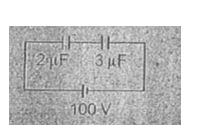A capacity of capacity C1 is charged up to V volt and then connected to an uncharged capacitor of capacity C2. Then final potential difference across each will be
C2C1+C2V0
C1C1+C2V0
C1+C2C2
C1+C2C1V0
The correct Answer is:B
To solve the problem step by step, we will analyze the situation where a charged capacitor C1 is connected to an uncharged capacitor C2.
1. Initial Charge on Capacitor C1:
- The capacitor C1 is charged to a potential V.
- The charge Q on capacitor C1 can be calculated using the formula:
Q=C1⋅V
2. Connecting Capacitors:
- When capacitor C1 is connected to the uncharged capacitor C2, the total charge Q remains constant, but it will redistribute between the two capacitors.
3. Final Voltage Across Both Capacitors:
- Let the final potential difference across both capacitors be Vf. Since they are in parallel, the voltage across both capacitors will be the same.
- The total charge after connection is still Q, which is now distributed across both capacitors. The relationship can be expressed as:
Q=C1⋅Vf+C2⋅Vf
- This can be rearranged to:
Q=Vf(C1+C2)
4. Substituting for Charge Q:
- Substitute Q=C1⋅V into the equation:
C1⋅V=Vf(C1+C2)
5. Solving for Final Voltage Vf:
- Rearranging the equation to solve for Vf:
Vf=C1⋅VC1+C2
6. Conclusion:
- The final potential difference across each capacitor after they are connected is:
Vf=C1⋅VC1+C2
Final Answer:
The final potential difference across each capacitor will be:
Vf=C1⋅VC1+C2
- The capacitor C1 is charged to a potential V.
- The charge Q on capacitor C1 can be calculated using the formula:
Q=C1⋅V
- When capacitor C1 is connected to the uncharged capacitor C2, the total charge Q remains constant, but it will redistribute between the two capacitors.
- Let the final potential difference across both capacitors be Vf. Since they are in parallel, the voltage across both capacitors will be the same.
- The total charge after connection is still Q, which is now distributed across both capacitors. The relationship can be expressed as:
Q=C1⋅Vf+C2⋅Vf
- This can be rearranged to:
Q=Vf(C1+C2)
- Substitute Q=C1⋅V into the equation:
C1⋅V=Vf(C1+C2)
- Rearranging the equation to solve for Vf:
Vf=C1⋅VC1+C2
- The final potential difference across each capacitor after they are connected is:
Vf=C1⋅VC1+C2
The final potential difference across each capacitor will be:
Vf=C1⋅VC1+C2
Topper's Solved these Questions
- ELECTROSTATIC POTENTIAL AND CAPACITORSBOOK - DC PANDEY ENGLISHCHAPTER - ELECTROSTATIC POTENTIAL AND CAPACITORSEXERCISE - (B) Chapter exercises
17 Videos
- ELECTROSTATIC POTENTIAL AND CAPACITORSBOOK - DC PANDEY ENGLISHCHAPTER - ELECTROSTATIC POTENTIAL AND CAPACITORSEXERCISE - (C) Chapter exercises
50 Videos
- ELECTROSTATIC POTENTIAL AND CAPACITORSBOOK - DC PANDEY ENGLISHCHAPTER - ELECTROSTATIC POTENTIAL AND CAPACITORSEXERCISE - Check point 2.5
20 Videos
- ELECTROMAGNETIC WAVESBOOK - DC PANDEY ENGLISHCHAPTER - ELECTROMAGNETIC WAVESEXERCISE - Sec C
22 Videos
- ELECTROSTATICSBOOK - DC PANDEY ENGLISHCHAPTER - ELECTROSTATICSEXERCISE - Medical entrances gallery
37 Videos
Similar Questions
A capacitor of capacitance C1 is charged to a potential difference V and then connected with an uncharged capacitor of capacitance C2 a resistance R. The switch is closed at t = 0. Choose the correct option(s):
View SolutionA capacitor of capacity C is charged to a potential difference V and another capacitor of capacity 2C is charged to a potential difference 4V. The charged batteries are disconnected and the two capacitors are connected with reverse polarity (i.e. positive plate of first capacitor is connected to negative plate of second capacitor). The heat produced during the redistribution of charge between the capacitors will be
View Solution
Knowledge Check
A capacitor or capacitance C1 is charge to a potential V and then connected in parallel to an uncharged capacitor of capacitance C2. The fianl potential difference across each capacitor will be
AC1VC1+C2BC2VC1+C2C1+C2C1D1−C2C1
A 100μF capacitor is charged to a potential difference of 24V. It is connected to an uncharged capacitor of capacitance 20μF What will be the new potential difference across the 100μF capacitor?
View SolutionA capacitor of capacitance C1 is charged to a potential V1 while another capacitor of capacitance C2 is charged to a potential difference V2 . The capacitors are now disconnected from their respective charging batteries and connected in parallel to each other .
(a) Find the total energy stored in the two capacitors before they are connected.
(b) Find the total energy stored in the parallel combination of the two capacitors.
(c ) Explain the reason for the difference of energy in parallel combination in comparison to the total energy before they are connected.
View SolutionFind charge on each capacitor and potential difference across each capacitor .

View SolutionA capacitor of capacitance C is charged to a potential difference V0. The charged battery is disconnected and the capacitor is connected to a capacitor of unknown capacitance Cx. The potential difference across the combination is V. The value of Cx should be
View SolutionThe energy stored in a capacitor of capacity C and potential V is given by
View SolutionA 10μF capacitor is charged to a potential difference of 50V and is connected to another uncharged capacitor in parallel. Now the common potential difference becomes 20 volt. The capacitance of second capacitor is
View SolutionA 10μF capacitor is charged to a potential difference of 50V and is connected to another uncharged capacitor in parallel. Now the common potential difference becomes 20 volt. The capacitance of second capacitor is
View Solution
